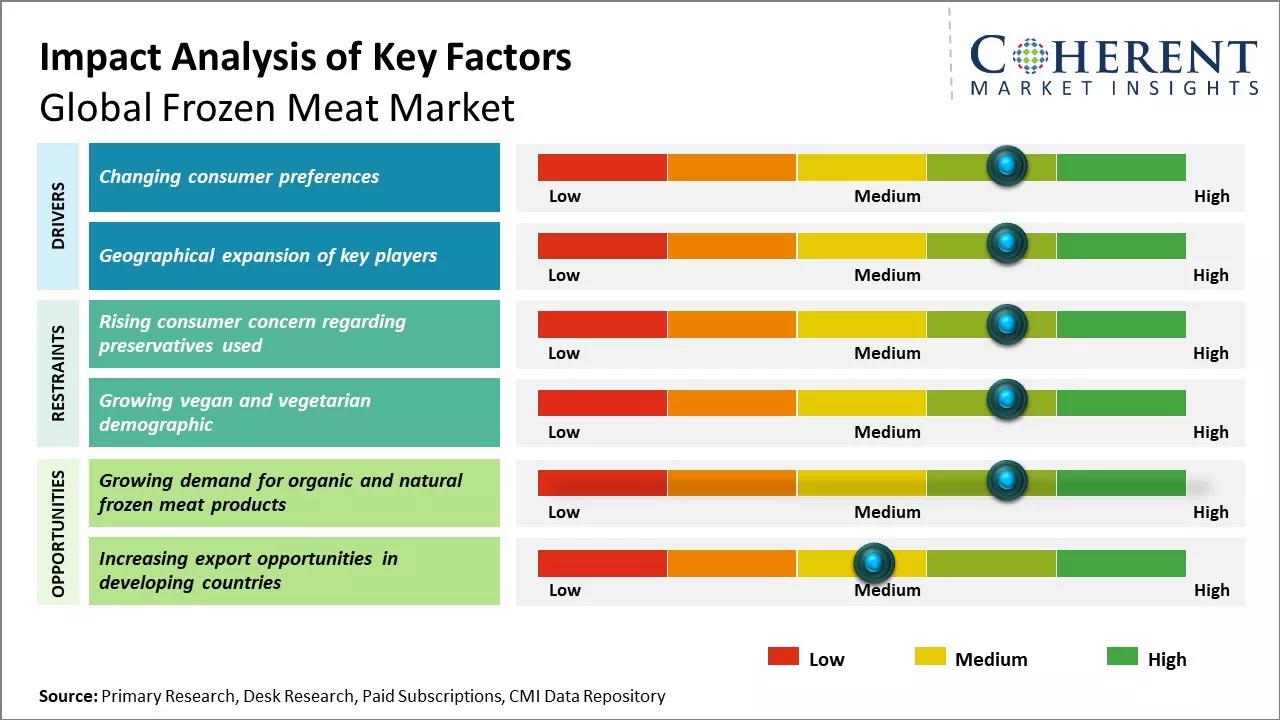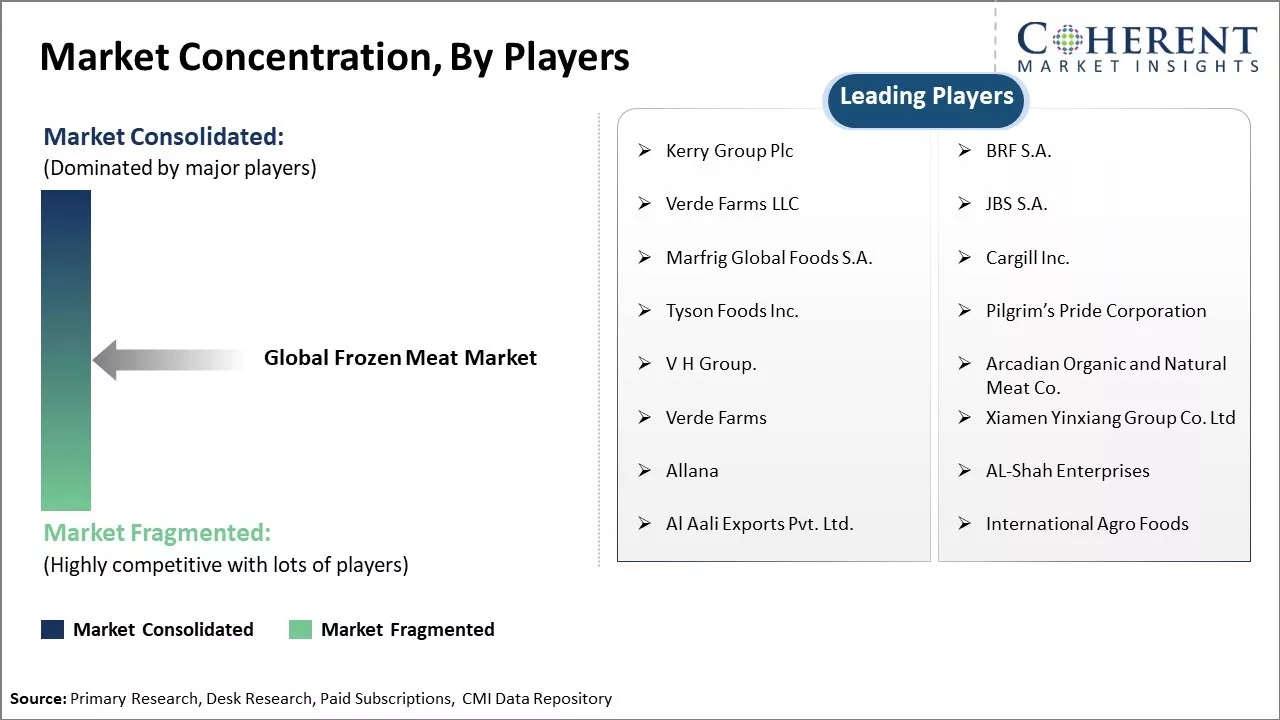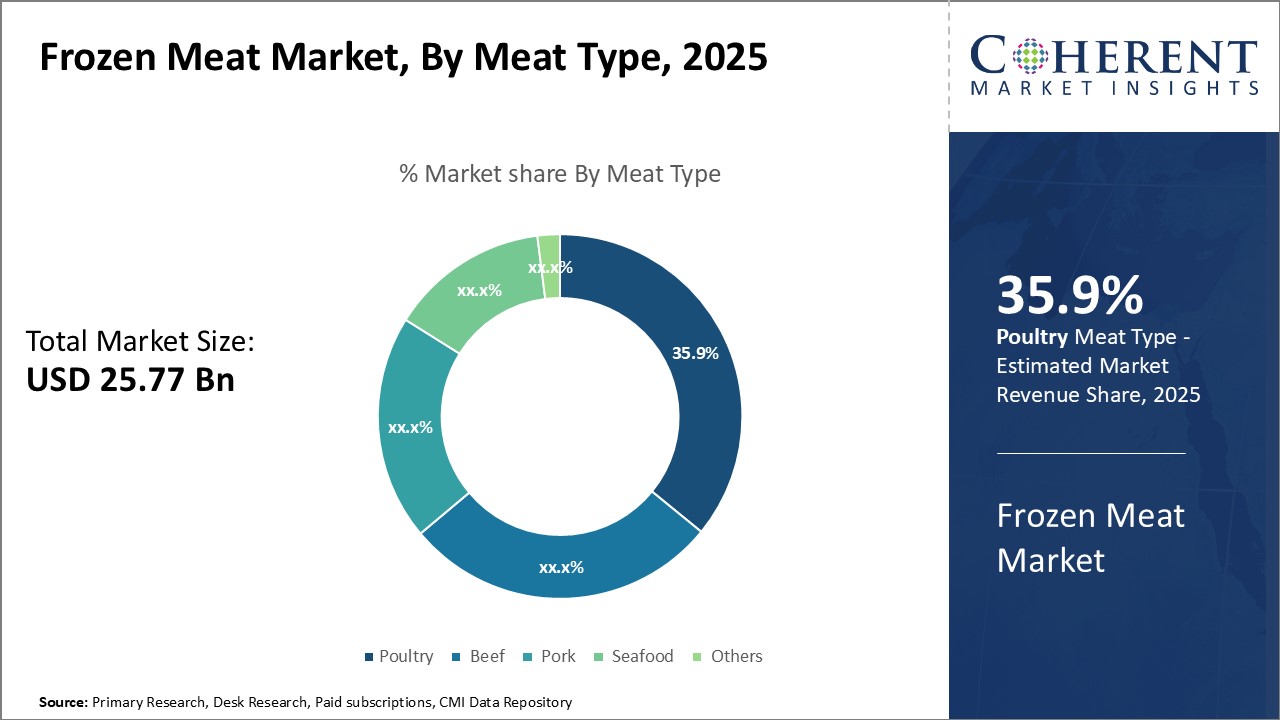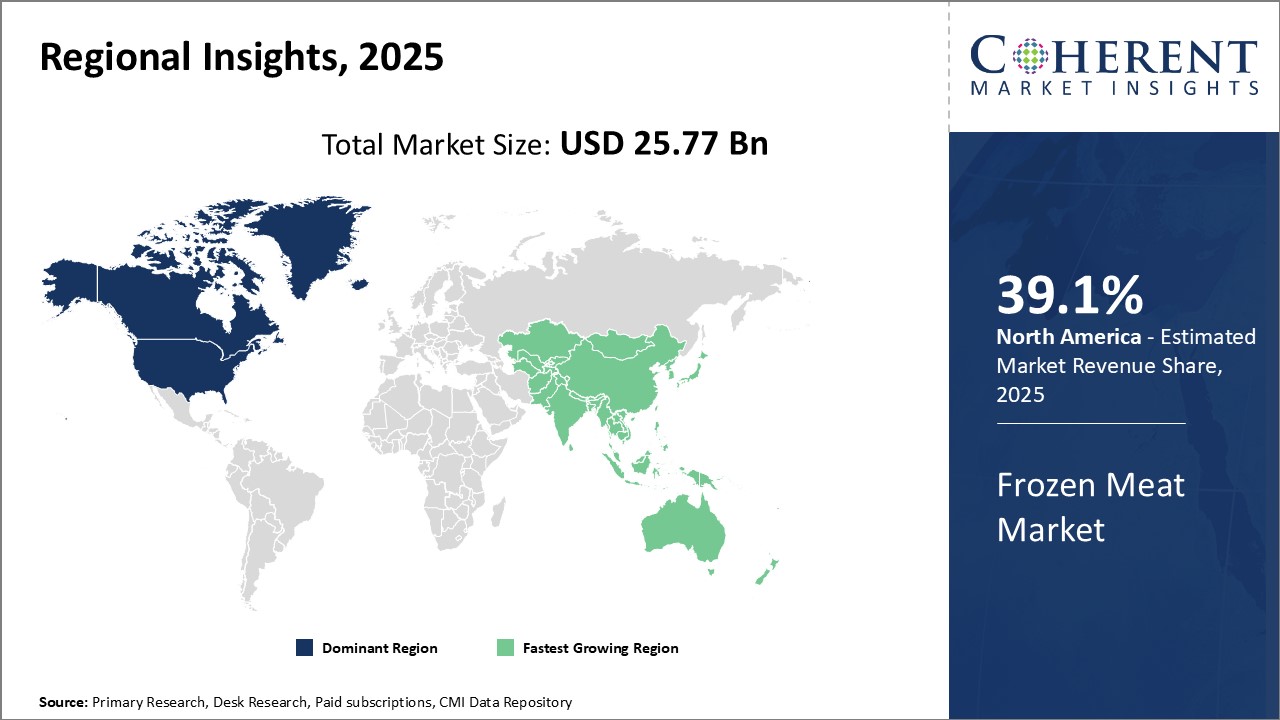The frozen meat market is estimated to be valued at USD 25.77 Bn in 2025 and is expected to reach USD 33.26 Bn by 2032, exhibiting a compound annual growth rate (CAGR) of 3.7% from 2025 to 2032.

Discover market dynamics shaping the industry: Request sample copy
The frozen meat market is expected to grow steadily over the forecast period. The growth of the market is driven by busy lifestyles and increasing demand for convenience foods. Frozen meat offers benefits like longer shelf life and availability throughout the year. Changing dietary patterns and rise of organized retailing are further expected to support the sales of frozen meat products. Manufacturers are focusing on launching improved frozen meat products with higher nutritional value. They are also offering various package sizes to cater to the requirements of different end users. However, high setup and operational costs associated with cold chains can pose a challenge to the growth of the frozen meat market.
Changing consumer preferences
The frozen meat market has been witnessing significant growth over the past few years owing to the changing consumption patterns and hectic lifestyles of consumers. With increasing dual-income households and nuclear families emerging as a trend in major countries, people are left with very little time to prepare elaborate meals on a daily basis. Frozen meat products offer a convenient solution as they require minimal preparation and cooking time. Moreover, attributes such as long shelf life and year-round availability are driving their demand among time-strapped consumers.
Over the past decade, people have become more health and diet conscious. They are now focusing on the consumption of lean meat, low fat meat cuts, and value-added frozen meat products that are low in calories and cholesterol. This trend has prompted frozen meat manufacturers to offer a wide variety of nutritional and healthy frozen meat options. Some of the popular lean frozen meat varieties available in the market include chicken breast fillets, extra lean ground beef, and turkey bacon. The growing health awareness is encouraging the uptake of low fat frozen meat alternatives.

Get actionable strategies to beat competition: Request sample copy
Geographical expansion of key players
The frozen meat market has been witnessing significant efforts from the leading players to expand their geographical outreach. Many international frozen food manufacturers are focusing on penetrating developing markets that offer high-growth opportunities. For instance, they are investing in production facilities and cold chain logistics in countries across Asia Pacific and Latin America to cater to the unmet demand from rural and semi-urban households. The easy availability of international frozen meat brands through expanding retail distribution networks is driving the market growth.
At the same time, local frozen food producers from emerging economies are also gaining ground and consolidating their position by offering region-specific product varieties at competitive prices. They are bringing innovations tailored to local tastes, such as variations in spice levels, cuts, and packaging formats. This allows them to better serve the requirements of local population. The geographical expansion strategies of both global as well as regional players have enabled frozen meat products to reach even the remotely located areas, thereby augmenting the market demand over the past few years.
Key Takeaways from Analyst:
The frozen meat market is expected to witness steady growth over the forecast period, driven by changing consumer lifestyles and preferences. Customers are increasingly demanding convenient packaged foods that save time in cooking and meal preparation. This has fueled the demand for frozen meat products that can be easily cooked and added to dishes. However, price sensitivity may restrain market prospects to some extent as frozen meat is generally slightly costlier than fresh meat.
North America currently dominates the global frozen meat market aided by strong consumption patterns and packaged food culture in the region. However, Asia Pacific is predicted to emerge as the fastest growing market, ascribing to rising urbanization, disposable incomes, and nuclear families in developing countries like India and China. These socio-economic factors are translating into higher demand for easy-to-cook frozen foods.
Manufacturers could benefit from expanding their product lines to cater to regional tastes and dietary habits. For example, introducing halal frozen meat products could unlock new opportunities in the large Middle Eastern and Southeast Asian markets. Companies must also focus on developing innovative packaging solutions that enhance the shelf life and quality retention of frozen meat products. Adopting sustainable packaging materials and production techniques will aid vendors in gaining popularity among health and environment-conscious consumers.
Market Challenges: Rising consumer concern regarding preservatives used
The rising consumer concern regarding various preservatives used in frozen meat is one of the major factors restraining the growth of global frozen meat market. Consumers are becoming increasingly conscious about the ingredients and chemicals used during the processing and preservation of frozen meat products. There is a growing preference for clean label and organic frozen meat items with no artificial preservatives. Various studies have linked certain preservatives like nitrites and nitrates to various health issues like cancer when consumed regularly over the long term. This increasing health consciousness among consumers has made them skeptical about quantities and kinds of preservatives added to frozen meat.
Market Opportunities: Growing demand for organic and natural frozen meat products
The growing demand for organic and natural frozen meat products presents a great opportunity for growth in the global frozen meat market. In recent years, health consciousness among consumers has increased significantly. Many consumers are actively seeking out organic, natural and clean label food options that are free from hormones, antibiotics and other chemicals. This trend towards healthier and more sustainable eating has also shifted towards the frozen meat category.

Discover high revenue pocket segments and roadmap to it: Request sample copy
Insights by Meat Type: Consumer preference for healthy and versatile meat
In terms of meat type, poultry is expected to contribute 35.9% share of the market in 2025. The poultry segment accounts for the largest share in the frozen meat market due to growing consumer preference for chicken and turkey meat over red meat. Poultry meat is considered a healthier option as it is low in fat and calories. It provides high quality protein while being relatively affordable. Turkey and chicken meat can be prepared in various ways making them very versatile for weekday meals as well as weekend entertaining. They are easily substituted for red meat in recipes to create protein-rich yet lighter dishes.
The rising health consciousness among consumers has boosted the demand for poultry meat. It is perceived as a better alternative to red meat in weight management diets. Poultry farming also has a relatively lower environmental impact than cattle or pig farming. This makes poultry meat an attractive choice for consumers looking to make sustainable food choices.
Insights by Distribution Channel: Convenience of one-stop shopping
Based on distribution channel, supermarkets/hypermarkets is expected to contribute 33.9% share of the market in 2025. The supermarkets/hypermarkets segment dominates the distribution landscape in the frozen meat market owing to the convenience they offer shoppers. These large format stores allow consumers to purchase all their frozen, chilled and grocery needs under one roof. They stock an expansive variety of chicken, beef, pork, and seafood cuts along with meal solutions. This one-stop shopping experience saves users considerable time otherwise spent visiting different stores.
Supermarkets have also upped their freezer capacities to accommodate the rising demand for frozen convenience foods. Their purchasing power enables them to offer frozen meat products at competitive prices. Loyalty and private label programs further entice consumers. Moreover, supermarkets promote frozen items through dedicated aisles, displays, and bundles. The growing popularity of meal kits has spurred these stores to assemble recipe ingredients in one package. This drives incremental frozen meat sales through impulse purchases. Strong logistical networks allow hypermarkets to replenish products efficiently keeping shelves stocked. Their dominance in the offline channel continues to make supermarkets the principal distribution channel for frozen meat.

Need a Different Region or Segment? Customize now
North America has established itself as the dominant region in the global frozen meat market. The region is expected to account for 39.1% of the market share in 2025. With its large population and heavy meat consumption, the U.S. accounts for the bulk of the demand. Major meat producers and processors operate in the region to cater to this extensive domestic need. North America's advanced cold chain logistics infrastructure helps ensure frozen meat products retain their quality during storage and transportation to different parts of the vast country. The presence of global food giants like Tyson Foods, JBS, Cargill and Smithfield Foods - which control over 60.5% of pork processing in the U.S. - has made North America a hub for innovation in frozen meat processing and packaging technologies. Many new offerings customized for consumer demands first emerge in the American marketplace. North American standards in food safety, quality assurance, and traceability are also internationally recognized. As a result, the region maintains healthy trade flows, being both a major importer and exporter.
Among developing markets, Asia Pacific has emerged as the fastest growing region for the frozen meat market. Countries like China, India, and Indonesia represent enormous opportunities due to their large and rapidly growing consumer bases. Rising incomes have supported greater meat intake in daily diets. However, domestic production struggles to keep pace with demand in many APAC nations. This makes the region highly import-dependent, with Australia, Brazil, and other suppliers enjoying increasing sales. Infrastructure to chill and freeze meat is also expanding in the Asia Pacific region to improve domestic supply chains and enable the development of robust food service and retail sectors for frozen products. Major foreign players have established production joint ventures or acquisitions to participate in the region's growth. With continued economic development and urbanization projected to fuel strong demand growth into the future, the Asia Pacific frozen meat market is set for significant gains.
Frozen Meat Market Report Coverage
| Report Coverage | Details | ||
|---|---|---|---|
| Base Year: | 2024 | Market Size in 2025: | USD 25.77 Bn |
| Historical Data for: | 2020 To 2024 | Forecast Period: | 2025 To 2032 |
| Forecast Period 2025 to 2032 CAGR: | 3.7% | 2032 Value Projection: | USD 33.26 Bn |
| Geographies covered: |
|
||
| Segments covered: |
|
||
| Companies covered: |
Kerry Group Plc, BRF S.A., Verde Farms LLC, JBS S.A., Marfrig Global Foods S.A., Cargill Inc., Tyson Foods Inc., Pilgrim’s Pride Corporation, V H Group., Arcadian Organic and Natural Meat Co., Verde Farms, Xiamen Yinxiang Group Co. Ltd, Allana , AL-Shah Enterprises, Al Aali Exports Pvt. Ltd., and International Agro Foods |
||
| Growth Drivers: |
|
||
| Restraints & Challenges: |
|
||
Uncover macros and micros vetted on 75+ parameters: Get instant access to report
*Definition: Frozen meat is meat that has been preserved by freezing at very low temperatures, typically below 0°C (32°F). This process helps to extend the shelf life of the meat and prevent the growth of harmful bacteria, mold, and yeast. Freezing meat also helps to maintain its quality, flavor, and nutritional value for an extended period.
Share
Share
About Author
Yash Doshi is a Senior Management Consultant. He has 12+ years of experience in conducting research and handling consulting projects across verticals in APAC, EMEA, and the Americas.
He brings strong acumen in helping chemical companies navigate complex challenges and identify growth opportunities. He has deep expertise across the chemicals value chain, including commodity, specialty and fine chemicals, plastics and polymers, and petrochemicals. Yash is a sought-after speaker at industry conferences and contributes to various publications on topics related commodity, specialty and fine chemicals, plastics and polymers, and petrochemicals.
Missing comfort of reading report in your local language? Find your preferred language :
Transform your Strategy with Exclusive Trending Reports :
Frequently Asked Questions
Joining thousands of companies around the world committed to making the Excellent Business Solutions.
View All Our Clients
US Reciprocal Tax Impact Analysis On Frozen Meat Market
Stay updated on tariff changes with expert insights and timely information